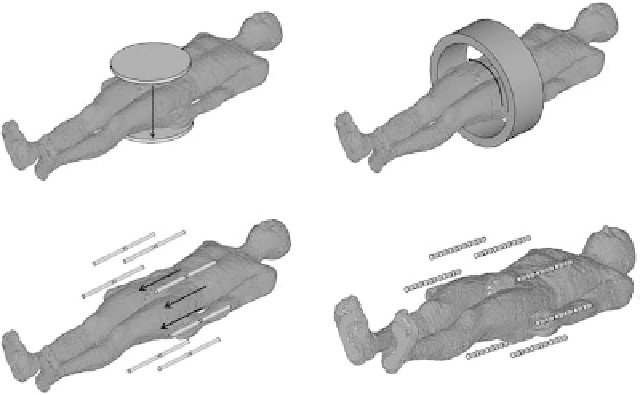Biomedical Engineering Reference
In-Depth Information
the resulting SAR distribution is determined by the square of the
total E-field. An advantage of coherent operation is that the power
deposition may be steered by varying the phases of the devices
in the array. For planar or approximately planar arrays, coherent
operation often results in more central power deposition while
incoherent operation tends to produce more peripheral power
deposition and a larger effective field size.
Arrays designed to provide superficial hyperthermia over
large surface areas such as the chest wall include a device con-
sisting of 25 microstrip spiral array elements driven at 915 MHz
(Lee et al. 1992) and a conformal microwave array consisting
of dual concentric conductor applicators (Stauffer et al. 2010).
Dual concentric conductor elements consist of multi-fed, quar-
ter wavelength square slot apertures (Rossetto et al. 2000). These
devices achieve large effective field sizes through choice of ele-
ments and individual control of each element in the array.
The use of nonplanar, for example, cylindrical, coherent
arrays offer marked advantages when heating tissues deep in
the body. Figure 4.15 shows schematic representations of several
methods that have been reported in attempts to achieve deep
heating within the body. The use of capacitive coupling produces
an E-field that is essentially perpendicular to the skin beneath
electrodes' footprints and often results in high SAR in superfi-
cial adipose tissue (D'Ambrosio and Dughiero 2007; Kroeze et
al. 2003), while a concentric coil encircling the body produces an
E-field that is essentially parallel to the skin but because of rota-
tional symmetry is zero on its central axis. In contrast, a cylindri-
cal annular array produces an E-field that is essentially parallel
to the skin but radiates from each source, and if the sources are
coherent, constructive interference of the fields can occur in
deep tissues. In practice, annular arrays have been constructed
using, for example, waveguide antennas (van Dijk et al. 1990;
Kok et al. 2010), or dipole antennas (Turner et al. 1989) coupled
to the patient by means of a bolus of demineralized water. Early
systems operated at a frequency in the range 70-110 MHz and
provided limited two-dimensional control of the SAR distribu-
tion. Subsequent clinical experience and numerical simulations
of annular-phased arrays led to improved designs based on mul-
tiple rings of antennas and capable of steering the resulting SAR
distribution axially within the patient. Wust et al. (1996) simu-
lated the performance of an array of up to 24 antennas arranged
in three rings of eight antennas and driven in various combina-
tions at 90 MHz and predicted that increasing the number of
individually controlled (particularly in terms of relative phase)
antennas led to improved tumor heating. In another simulation
study in which SAR averaged over the volume of targeted tis-
sue was compared with the volume averaged SAR outside the
targeted tissue according to three objective functions, Paulsen
et al. (1999) investigated the effects of varying the number and
distribution of sources, their operating frequency, and the posi-
tion of the target tissue. Results suggested that improved heating
of the pelvic region could be achieved by increasing the operat-
ing frequency to around 150 or 200 MHz depending upon the
number of antennas, increasing the number of antennas placed
circumferentially around the patient, and increasing the num-
ber of rings of antennas axially. Seebass et al. (2001) also studied
optimal frequency and antenna arrangement for regional hyper-
thermia and used both power- and temperature-based objective
functions to assess performance. Their results were in qualita-
tive agreement with those of Paulsen et al. (1999) and suggested
that the optimal system consisted of three rings of sources, each
with six or eight channels per ring, and an operating frequency
of around 150 MHz. Subsequent experience of simulation of
regional hyperthermia arrays and the importance of treatment
planning are discussed by Wust and Weihrauch (2009). A com-
mon feature of most annular array systems is the incorporation
FIGURE 4.15
Examples of techniques reported for deep heating within the body.
Top left: Capacitive coupling of E-field. Top right:
Inductive coupling using a concentric coil. Lower left: An array of dipole antennas distributed around the body on a circular cylin-
der. Lower right: 24 dipoles arranged in three rings of eight antennas distributed around the body on a cylinder of elliptical cross
section.

